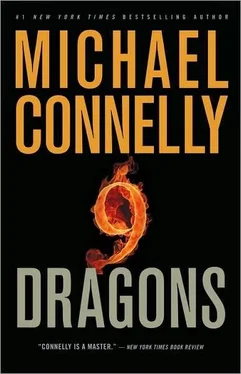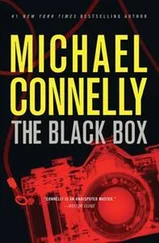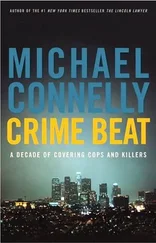“No, but Dr. Laksmi at the ME’s sprayed blood off it with water. It was found inside the victim.”
“Inside? That’s impossible. There’s no way a casing could-”
“I don’t mean he was shot with it. He tried to swallow it. It was in his throat.”
“Oh. That’s different.”
“Yeah.”
“And Laksmi would have been gloved up when she found it.”
“Right. What’s up, Ross?”
“Well, I was thinking. We got a flyer about a month ago from latents. It said they were getting ready to start using some new state-of-the-art, electro-something-or-other method of raising prints on brass casings, and they were looking for test cases. You know, to get it into court.”
Bosch stared at Malone. In all his years of detective work he had never heard of fingerprints being raised on a casing that had been fired in the chamber of a gun. Fingerprints were made of oils from the skin. They burned up in the millisecond of explosion in the chamber.
“Ross, you sure you’re talking about spent casings?”
“Yeah, that’s what it said. Teri Sopp is the tech over there handling it. Why don’t you go see her?”
“Give me back the casing and I will.”
Fifteen minutes later Bosch was with Teri Sopp in the SID’s latent fingerprints lab. Sopp was a senior examiner and had been around nearly as long as Harry. They had an easy comfort with each other but Bosch still felt he had to finesse the meeting and lead Sopp to the water.
“Harry, what’s the story?”
It was how she always greeted Bosch.
“The story is I caught a case yesterday down south and today we recovered a single bullet casing from the shooter’s gun.”
Bosch raised his hand, holding out the evidence bag with the casing in it. Sopp took it, held it up and squinted as she studied it through the plastic.
“Fired?”
“Yup. I know it’s a long shot but I was hoping maybe there’d be a print on it. I don’t have much else going on the case at the moment.”
“Well, let’s see. Normally, you’d have to wait your turn but seeing how we go back about five police chiefs?…”
“That’s why I came to you, Teri.”
Sopp sat down at an examination table and, like Malone, used a pair of tweezers to pull the casing from the evidence bag. She first fumed it with cyanoacrylate and then held it under an ultraviolet light. Bosch was watching over her shoulder and had the answer before Sopp voiced it.
“You have a smear here. Looks like somebody handled it after it was fired. But that’s all.”
“Shit.”
Bosch guessed that the smear had most likely been left on the casing when John Li grabbed it and put it in his mouth.
“Sorry, Harry.”
Bosch’s shoulders sagged. He knew it was a long shot, or maybe a no shot, but he was hoping to convey to Sopp how much he had counted on getting a print.
Sopp started to put the casing back into the evidence envelope.
“Tool Marks look at this yet?”
“Yeah, I just came from there.”
She nodded. Bosch could tell she was thinking about something.
“Harry, tell me about the case. Give me the parameters.”
Bosch summarized the case but left out the detail about the suspect they had pulled out of the surveillance video. He made it sound like the investigation was almost hopeless. No evidence, no suspect, no motive other than common robbery. Zip, nada, nothing .
“Well, there’s one thing we might be able to do,” Sopp said.
“What’s that?”
“We’ll be putting a bulletin out by the end of the month on this. We’re gearing up for electrostatic enhancement. This might be a good first case for us.”
“What the hell is electrostatic enhancement?”
Sopp smiled like the kid who still had candy after you were all out.
“It’s a process that was developed in England with the Northamptonshire police by which fingerprints can be raised on brass surfaces such as bullet casings by using electricity.”
Bosch looked around, saw an empty stool at one of the other workstations and dragged it over. He sat down.
“How’s it work?”
“Okay, here’s the deal. When you load bullets into a revolver or a magazine for an automatic, it is a precise process. You hold each bullet between your fingers and you push it in. You apply pressure. It would seem like a perfect setup for leaving prints, right?”
“Well, until the gun is fired?.”
“Exactly. A latent print is essentially a deposit of the sweat that builds between the grooves of your fingerprint. The problem is, when a gun is fired and the casing is ejected, the latent print usually disappears in the explosion. It’s rare that you pull a print off a spent shell, unless it belongs to the person who picked it up off the ground after.”
“All this I know,” Bosch said. “Tell me something I don’t know.”
“Okay, okay. Well, this process works best if the gun is not immediately fired. In other words, for this process to be successful, you need a situation where maybe the bullet was loaded into the gun but then allowed to sit in there for at least a few days. The longer, the better. Because if it’s sitting in there, the sweat that forms the latents is reacting with the brass. You understand?”
“You mean there’s a chemical reaction.”
“A microscopic chemical reaction. Your sweat is made up of a lot of different things but mostly sodium chloride-salt. It reacts with the brass-corrodes it-and leaves its mark. But we just can’t see it.”
“And the electricity lets you see it.”
“Exactly. We run a twenty-five-hundred-volt charge through the casing, dust it with carbon and then we see it. We’ve run several experiments so far. I’ve seen it work. It was invented by this guy named Bond in England.”
Bosch was growing excited.
“Then, why don’t we do it?”
Sopp spread her fingers in a calming gesture.
“Whoa, hold on, Harry. We can’t just do it.”
“Why not? What are you waiting for, a ribbon-cutting ceremony with the chief or something?”
“No, it’s not that. This kind of evidence and procedure has not been introduced in a California court yet. We’re working with the district attorney on protocols and nobody wants to go out with this for the first time on a case where it’s not a slam-dunk. We have to think of the future. The first time we use this process as evidence will set the precedent. If it’s not the right case, we’ll blow it and it would really set us back.”
“Well, maybe this is the case. Who decides that?”
“It’s first going to be up to Brenneman to pick the case and then he’ll take it to the DA.”
Chuck Brenneman was the commander of the Scientific Investigation Division. Bosch realized that the process of choosing the first case could take weeks, if not months.
“Look, you said you guys in here have been experimenting with it, right?”
“Yeah, we have to make sure we know what we’re doing.”
“Good, then experiment with this casing. See what you come up with.”
“We can’t, Harry. We’re using dummy bullets in a controlled experiment.”
“Teri, I need this. There might be nothing there but then again, the killer’s print might be on that shell. You can find out.”
Sopp seemed to realize that she had been cornered by someone who was not going to go away.
“All right, listen. The next set of experiments is not scheduled till next week. I can’t promise anything but I’ll see what I can do.?”
“Thanks, Teri.”
Bosch filled out the chain-of-evidence form and left the lab. He was excited about the possibility of using the new science to possibly get the killer’s print. It almost felt to him as if John Li had known about electrostatic enhancement all along. The thought sent a different kind of electricity down Bosch’s spine.
Читать дальше












